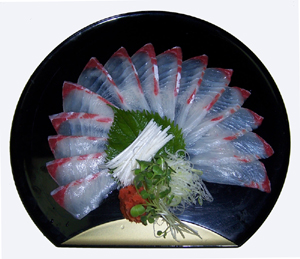Sashimi

is a Japanese delicacy. It primarily consists of very fresh raw seafood, sliced into thin pieces and served with only a dipping sauce (soy sauce with wasabi paste or other condiments such as grated fresh ginger, or ponzu), depending on the fish, and simple garnishes such as shiso and shredded daikon radish. Dimensions vary depending on the type of item and chef, but are typically about 2.5 cm (1") wide by 4 cm (1.5") long by 0.5 cm (0.2") thick. The word sashimi means "pierced body", sashi (pierced, stuck) and = mi (body, meat). This word had used from Muromachi period, withheld the word "?? = Cut ,the culinary step, by Samurai for inauspiciousness. This word may derive from the culinary practice of sticking the fishs tail and fin to the slices in identifying the fish being eaten. Another possibility for the name could come from the traditional method of harvesting. Sashimi Grade fish is caught by individual handline, and as soon as the fish is landed, its brain is pierced with a sharp spike, killing it instantly, then placed in slurried ice. This spiking is called the Ike jime process. Because the flesh contains minimal lactic acid due to the animals quick death, it will keep fresh on ice for about 10 days without turning white or otherwise degrading. [citation needed] The word sashimi has been integrated into the English language and is often used to refer to other uncooked fish preparations besides the traditional Japanese dish subject of this article. Many non-Japanese conflate sashimi and sushi; the two dishes are actually distinct and separate. Sushi refers to any dish made with vinegared rice, and while raw fish is one traditional sushi ingredient, many sushi dishes contain seafood that has been cooked, while others have no seafood at all.
|


